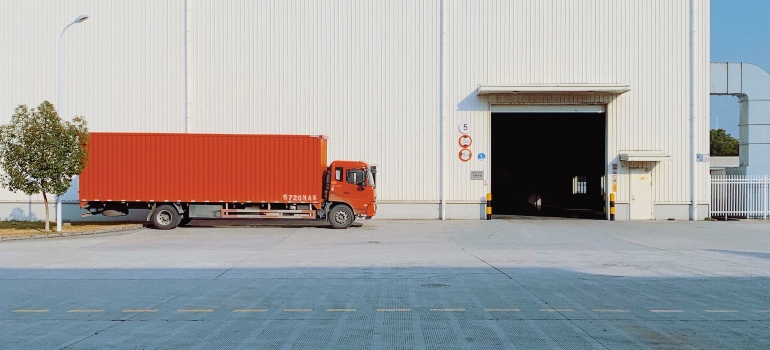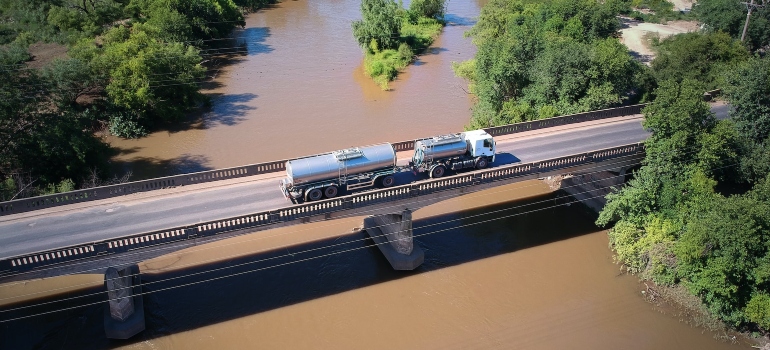The Basics of Route Planning for Efficient Logistics
Route planning in logistics is an art and science that dictates the pulse of modern supply chains. It significantly influences the efficiency of transportation and, ultimately, the success of businesses. In recent years, technological advancements have revolutionized the approach to route planning, transforming it from a simple exercise in map reading to a complex orchestration involving sophisticated software and predictive analytics. Hence, to underscore the pivotal role of route planning for efficient logistics, our Peasley Moving & Storage team will emphasize how it optimizes resources, enhances customer satisfaction, and contributes to the environmental sustainability of transportation networks. So, explore its fundamentals, the role of technology, influencing factors, prevailing challenges, and best practices, and get a glimpse into its future.
The Fundamentals of Route Planning
In logistics, route planning refers to determining the most efficient paths for vehicles to follow to achieve specific objectives. This process is crucial in logistics and transportation management, which involves mapping out routes for delivering goods or services. Here’s a detailed look at its importance:
- Efficiency and Cost Reduction: Effective route planning minimizes travel distances and times, reducing fuel consumption and operational costs. This efficiency is vital in a competitive logistics market, where optimizing resource use can significantly impact profitability.
- Safety and Compliance: Planning ensures safer deliveries and travel for drivers by avoiding high-risk areas. This aspect is particularly important in regions with challenging terrain or adverse weather conditions, and it helps companies adhere to safety regulations.
- Environmental Impact: In today’s environmentally conscious world, reducing carbon emissions is a priority for many businesses. Efficient route planning contributes to this goal by minimizing unnecessary travel, thereby reducing the carbon footprint of logistics operations.
- Customer Satisfaction: Timely deliveries are crucial for customer satisfaction in logistics. Well-planned routes ensure deliveries are made quickly and reliably, especially in time-sensitive sectors like e-commerce and perishable goods.
- Driver Satisfaction and Retention: Effective planning leads to improved driver satisfaction. Reducing time on the road and avoiding complicated routes helps prevent driver burnout, leading to better retention rates.
- Adaptability and Responsiveness: The ability to quickly adapt to changing circumstances, such as traffic conditions or last-minute delivery requests, is enhanced through dynamic route planning. This flexibility is key to maintaining high service levels in an unpredictable environment.
- Maximizing Resource Utilization: Optimizing routes allows companies to maximize their available vehicles and personnel. This means more deliveries can be completed with fewer resources, maximizing the workforce’s and fleet’s utility.
Therefore, route planning is a multi-faceted process with extensive benefits in logistics. From reducing costs and improving safety to enhancing customer and driver satisfaction, its role is integral to the success and sustainability of logistics operations.

Factors Influencing Route Planning
Various factors influence route planning in logistics, each playing a crucial role in determining the most efficient and effective paths for transportation. One of them is traffic patterns. Understanding and anticipating traffic flow is essential for avoiding delays. Logistics planners often use real-time traffic data to predict congested areas and plan alternative routes. This data is crucial during peak hours or in densely populated urban areas where traffic can significantly impact delivery times.
Weather conditions also play a pivotal role, as adverse weather can lead to road closures or slow-downs, impacting delivery schedules. Planners must consider forecasts and historical weather patterns to anticipate potential disruptions and plan accordingly. This might involve choosing routes less likely to be affected by severe weather or allocating extra time for deliveries during certain seasons.
Vehicle capacity is another critical factor. Vehicles’ size and load capacity determine how much cargo can be transported at once, influencing the number of trips required. Efficient planning involves maximizing the cargo load while ensuring safe and manageable driving conditions. This requires a careful balance between vehicle capacity and the number and size of deliveries.
Delivery windows are also crucial. Customers often have specific time frames within which they expect deliveries. Planners must consider these windows when designing routes to ensure timely deliveries. This involves freight shipping companies coordinating with customers and drivers to understand time constraints and plan routes that can realistically meet these expectations.
Integrating these factors into the route planning process involves a combination of technology, experience, and strategic thinking. Advanced software tools can analyze vast amounts of data on traffic patterns, weather forecasts, vehicle capacities, and delivery schedules to suggest optimal routes. However, human expertise is also essential in interpreting this data and making final decisions based on real-world conditions and experience.

Challenges in Route Planning for Efficient Logistics
Route planning faces several challenges, each requiring specific strategies to mitigate. Unpredictable traffic is a major one. Traffic conditions can change rapidly due to accidents, roadworks, or events. To minimize this, logistics companies use GPS and traffic monitoring systems that provide real-time updates, allowing drivers to alter their routes as needed.
Changing customer demands presents another issue. Customers may request last-minute changes to delivery times or locations. To handle this, flexibility is built into the route planning process. This might involve scheduling buffer times or having additional resources on standby to accommodate changes.
Another challenge is balancing efficiency with driver welfare. Long or complex routes can lead to driver fatigue, impacting safety and performance. Freight companies must ensure that routes are efficient and manageable for drivers. This involves considering factors like driving hours, rest periods, and the complexity of the roads.
Environmental factors, such as reducing carbon emissions, also pose a challenge. Companies are increasingly seeking to minimize their ecological impact. This involves planning routes that reduce fuel consumption, such as choosing the shortest possible routes or avoiding areas with heavy traffic where vehicles might idle for long periods.
To overcome these challenges, logistics companies increasingly use advanced route planning software. These tools can process large amounts of data to provide optimized routes considering traffic, weather, and customer demands. However, the human element remains crucial. Experienced logistics planners must use their judgment and knowledge of local conditions to tweak and finalize routes, ensuring they are realistic and consider all variables.

Best Practices in Route Planning
Effective route planning in logistics is a complex task that requires a strategic approach. Here are some best practices:
- Leverage Technology: Use advanced route planning software to analyze traffic patterns, weather conditions, and customer preferences. These tools can provide optimized routes and help in making informed decisions.
- Understand Your Fleet: Know the capacity and capabilities of each vehicle in your fleet. This understanding helps assign the right vehicle to the appropriate route, ensuring efficient use of resources.
- Prioritize Customer Needs: Align routes with customer delivery windows and preferences. This customer-centric approach helps in maintaining high satisfaction levels.
- Plan for Contingencies: Always have a backup plan. Unforeseen circumstances like traffic jams or vehicle breakdowns can disrupt planned routes. Having alternative routes or extra time slots can help manage such situations effectively.
- Regularly Review and Optimize Routes: Routinely analyze the efficiency of your routes. Continuous improvement based on past performance and feedback can lead to more effective planning.
- Ensure Driver Safety and Compliance: Reputable door-to-door shipping international companies plan efficient and safe routes for drivers. Therefore, comply with driving hours and rest periods regulations to ensure driver welfare.
- Flexibility and Real-Time Adjustments: Adapting to real-time changes is crucial. Flexibility allows for adjustments to traffic updates, weather changes, or last-minute customer requests.
The essence of best practices in route planning for efficient logistics hinges on smartly integrating technology with a deep understanding of operational dynamics. It’s about balancing efficiency with adaptability, ensuring routes are optimized for current conditions and flexible enough to accommodate unforeseen changes. This approach, centered on continuous improvement and responsiveness to both customer and operational needs, is key to achieving success in logistics route planning.

The Future of Route Planning in Logistics
The future of route planning in logistics looks promising with the integration of emerging technologies. Autonomous vehicles are set to revolutionize delivery processes, offering more efficient and cost-effective solutions. These self-driving vehicles can potentially operate around the clock, reducing human error and increasing delivery speeds.
Advanced analytics and AI can process vast amounts of data to predict traffic patterns, optimize routes, and even anticipate maintenance needs. This level of sophistication in route planning will lead to unprecedented efficiency and accuracy in logistics operations.
In addition to autonomous vehicles and advanced analytics, integrating the Internet of Things (IoT) in logistics is set to enhance route planning further. IoT devices can provide real-time data from vehicles and cargo, allowing for more dynamic and responsive route adjustments. This technology can help monitor vehicle health, cargo conditions, and environmental factors, contributing to more informed decision-making.
Moreover, using drones for delivery, especially in hard-to-reach areas or for small, urgent deliveries, is likely to become more prevalent. Drones can bypass traditional road networks, offering a faster and more direct route to the destination. This innovation could significantly reduce delivery times and open up new possibilities for route planning.
Another emerging trend is the increased focus on sustainability in logistics. Route planning will likely incorporate eco-friendly practices, such as optimizing routes for lower emissions and integrating electric or hybrid vehicles into fleets. This shift addresses environmental concerns and aligns with the growing consumer demand for sustainable business practices.
Finally, the potential for more collaborative logistics networks, where different companies share data and resources, could lead to more efficient route planning industry-wide. Such collaboration can result in shared delivery routes, reducing the number of vehicles on the road and overall transportation costs.

Integrating Sustainability into Route Planning
Integrating sustainability into route planning has become increasingly important in the evolving logistics landscape. This integration addresses environmental concerns and contributes to long-term operational efficiency and corporate responsibility.
- Eco-Friendly Route Optimization: Sustainable route planning aims to optimize routes to reduce fuel consumption and emissions. This involves selecting the shortest and most efficient paths and considering traffic congestion and vehicle idling times. Advanced route planning software can analyze these factors to create routes that minimize environmental impact.
- Use of Alternative Fuels and Vehicles: Incorporating vehicles powered by alternative fuels, such as electricity or biodiesel, is a significant step towards sustainability. These vehicles produce fewer emissions compared to traditional fuel vehicles. As technology advances, the feasibility and efficiency of these alternatives are improving, making them a viable option for more logistics companies.
- Load Optimization: Maximizing the load capacity of each vehicle reduces the number of trips required, thereby decreasing the overall carbon footprint. This involves physical space utilization and weight management to ensure safe and efficient transport.
- Driver Training and Behavior: Educating drivers on eco-friendly driving practices can have a substantial impact. Techniques like efficient gear usage, maintaining steady speeds, and avoiding unnecessary idling can reduce fuel consumption and emissions.
- Collaborative Logistics: Sharing logistics networks and resources between companies can reduce vehicle usage and lower emissions. This collaborative approach can optimize delivery routes and loads, leading to more efficient use of transportation resources.
- Data-Driven Decision Making: Utilizing data analytics for route planning allows for more accurate predictions and adjustments. This can lead to better resource allocation, reduced waste, and a smaller environmental footprint.
- Regular Review and Adaptation: Sustainability is an ongoing process. Regularly reviewing and adapting route planning strategies to incorporate new technologies, insights, and environmental considerations is crucial.
Incorporating sustainability into route planning is not just an environmental imperative but also a business necessity. As consumer awareness and regulatory pressures increase, logistics companies that adopt sustainable practices in their route planning are likely to gain a competitive edge, improve their operational efficiency, and contribute positively to the global effort of reducing environmental impact.
Embracing the Future of Logistics Through Strategic Route Planning
As we look towards the future, the significance of strategic route planning for efficient logistics becomes increasingly clear. It stands as a cornerstone in the industry for its immediate benefits in efficiency and customer satisfaction and for shaping a more sustainable and adaptable logistics landscape. The integration of advanced technologies, a commitment to environmental responsibility, and a focus on continuous improvement are driving a new era in logistics management. This evolution is not just about meeting the demands of today but is also a proactive step towards a more efficient, responsible, and customer-focused future. The logistics journey is one of constant advancement, and at its heart lies the art and science of route planning – a field that combines technology, human insight, and strategic thinking to keep the world moving forward.

Everyone from the packers to the movers were awesome! They were all very professional and showed up when they were supposed to. would definitely use them again.

